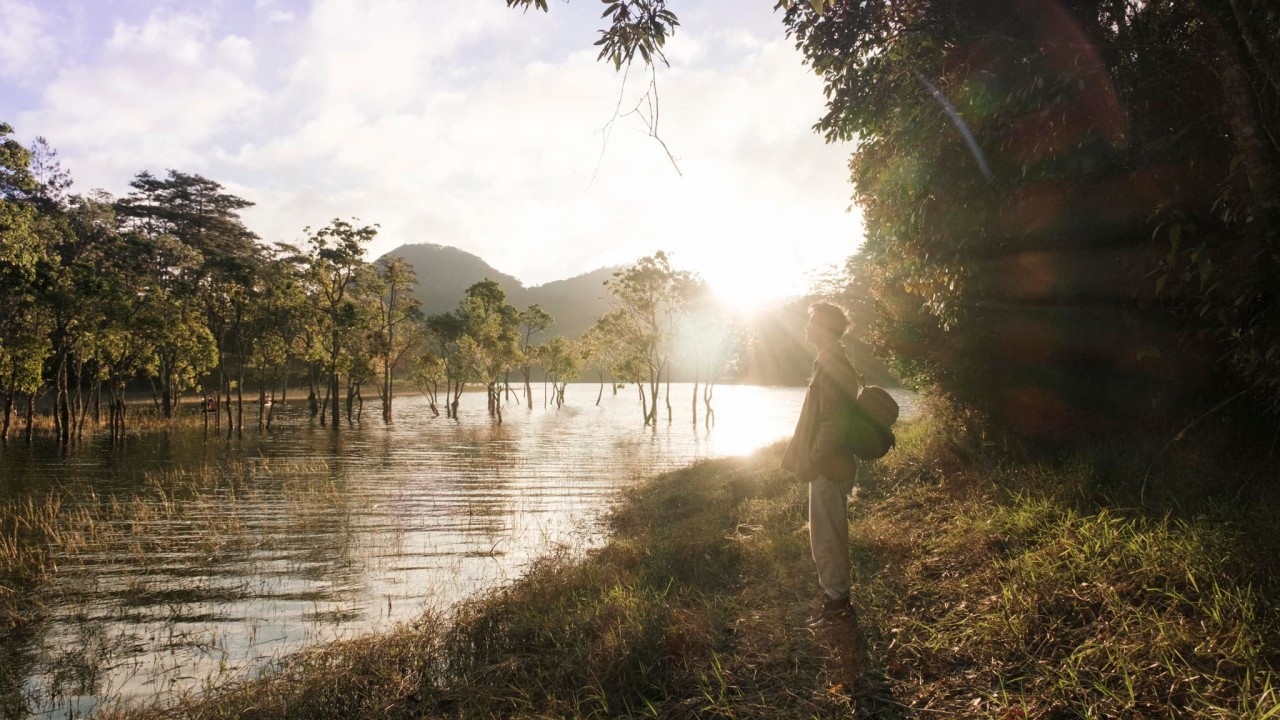For many travelers visiting Da Lat, Tuyen Lam Lake needs no introduction as it is the city’s largest freshwater lake. However, only a small number of people know about the origin of the water that flows into the lake via Suoi Tia.
The hills and mountains surrounding the Suoi Tia flow form a basin-like terrain. It was between 1985 and 1986 that the People’s Committee of Lam Dong province and Duc Trong district constructed dams to retain water in the Suoi Tia area, thus creating Tuyen Lam Lake as we know it today, as per the information provided on the Lam Dong Province online information portal.
 |
| The beautiful early morning at the Suoi Tia area. Photo: Manh Hung |
The area surrounding the Suoi Tia flow is encircled by mountain ranges that shape a basin-like terrain and is home to thriving bamboo forests. The bamboo forest takes on a different kind of beauty with every passing season.
Especially during spring, the slender bamboo trees stretching up into the sky make for a beautiful spectacle with their thin spindly trunks reaching towards the heavens, attracting photographers to capture the most mesmerizing shots.
Bui Ngoc Lam, a 25-year-old tourist from Hanoi, shared his experience of visiting Suoi Tia on November 22nd. He mentioned that the road leading from the Da Lat city center to Suoi Tia is about 15 kilometers long and quite pleasant, except for a small 100-meter stretch that was under repair. Tourists can either ride a motorbike or take a pickup truck to reach Suoi Tia and then walk the remaining 300 meters to arrive at the destination.
 |
| Tourists can hire a boat to explore the upstream area. Photo: Manh Hung |
Visitors to Suoi Tia can thoroughly experience the charm of all four seasons in a single day, thanks to the changing scenes with the time of day. The misty ambiance in the early hours of the morning evokes the feeling of spring. As the sun rises and shines brightly, the temperature rises, creating a summer-like warmth. The afternoon brings a sense of quietude, akin to autumn. As night falls, the temperature drops, giving way to the chilly atmosphere of winter.
Suoi Tia possesses a wild and natural beauty, with minimal commercial development. Its cool and refreshing air makes it an ideal spot for camping and relaxation amidst nature’s tranquility. The lake is perfect for recreational activities such as SUP boarding or kayaking for those who enjoy being active.
 |
| The entrance to Suoi Tia is through a pine forest trail, so it’s easy to get lost without a guide. Photo: Manh Hung |
The entrance to Suoi Tia is a trail that leads through a pine forest, making it easy to lose one’s way without a guide. Visitors can go to the boat pier at Tuyen Lam Lake and hire a boat to take them to Suoi Tia. The cost varies depending on the number of people.
The optimal time to visit Suoi Tia is between January and April, when the weather is at its best and there is little to no rain. Visitors should arrive before 6:30 AM to catch the breathtaking sight of the first rays of sunlight illuminating the rows of bamboo trees, which appear radiant against the magical white mist. It’s important to note that the early morning temperature in Da Lat can be quite chilly, so visitors should bring warm clothing.
Every corner of Suoi Tia offers a picturesque setting for photography. Visitors are kindly requested to clean up after themselves and dispose of any trash responsibly to preserve the natural beauty of Tuyen Lam Lake and its surroundings.
 |
| At Suoi Tia, every corner offers a perfect backdrop for captivating photos. Photo: Manh Hung |
With its unspoiled charm, visitors could easily mistake Tuyen Lam Lake for a natural body of water. However, it is an artificial lake that was created in the 1930s and later discovered by a French farmer named Farraut. At the time, Tuyen Lam Lake was surrounded by the majestic Elephant Mountain and connected to the picturesque Purple Stream.
Taking a boat trip on the waters of Tuyen Lam Lake offers tourists a mesmerizing experience unlike any other. The sky above is adorned with pristine white clouds, while the boat glides past rolling hills shrouded in a blanket of vaporous fog, mirroring their forms on the calm and serene water’s surface.
Legendary Lang Biang
In June 2015, at the 27th Session of the International Coordinating Council of UNESCO’s Man and Biosphere Program (ICC-MAB) held in Paris, the Lang Biang Natural Reserve in Vietnam’s Central Highlands Lam Dong Province has been recognised as a UNESCO Biosphere Reserve. Lang Biang Reserve has retained its values of bio-diversity on a global scale, with the natural scenery mixed in harmony with local cultural features. It has contributed to forming and developing Da Lat to become a city of tourism and an international research centre on tropical forest.
Da Lat flower festival promises attractive activities
NDO/VNA – The eighth Da Lat Flower Festival, themed “Da Lat and Flowers”, will take place in the Central Highlands province of Lam Dong from December 20-24.
Unique Clay Architecture and Sculpture in Da Lat
For years, Da Lat has been known as a charming city with vast flowers gardens, winding mountain passes, green pine forests and amiable people. This fairy city is now famous for another appealing attraction; a unique clay tunnel, which is called by different names, such as sculptured tunnel, basalt tunnel or clay village.








